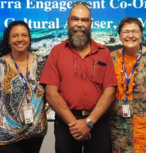DNA reveals the past and future of coral reefs
New DNA techniques are being used to understand how coral reacted to the end of the last ice age in order to better predict how they will cope with current changes to the climate. James Cook Univer

From 2005 to 2022, the main node of the ARC Centre of Excellence for Coral Reef Studies was headquartered at James Cook University in Townsville, Queensland (Australia)








This talk is the second of three on parachute science being organized by the ARC CoE Justice, Equity, Diversity and Inclusion (JEDI) committee.
Abstract
For millenia, Traditional Owners have held inherent rights, interests in and knowledge of Australia’s marine environment, but are yet to be considered equal partners in marine research. Australia adopted the UN Declaration on the Rights of Indigenous Peoples in 2009, obliging us to “consult and cooperate in good faith with the indigenous peoples … in order to obtain their free, prior and informed consent before adopting and implementing legislative or administrative measures that may affect them.” However, there is a disconnect between this obligation and the statutory regulation of marine research. Nevertheless, there has been steady progress. For example, 13% of the Great Barrier Reef World Heritage Area is now subject to formal statutory arrangements with Traditional Owners (Dale et al 2019), and vast areas of Torres Strait sea country now lie within a Native Title sea claim (NNTT 2019).
Besides improving the quality, value and impact of marine research outputs and outcomes, Indigenous marine science partnerships also uphold Traditional Owners’ inherent rights, responsibilities, interests and knowledge of the marine environment. The refreshed ‘AIMS Strategy2025’ recognises this with an ambitious target for Indigenous partnerships to take a central place within the AIMS research program. This joint presentation will:
a) introduce the AIMS Indigenous Partnerships Plan and Policy, including the tiered engagement approach that underpins it and its implementation across the AIMS port-folio and beyond (Libby); and
b) describe some resulting example Indigenous partnership projects with Traditional Owners in the Kimberley and on the GBR (Bob).
New DNA techniques are being used to understand how coral reacted to the end of the last ice age in order to better predict how they will cope with current changes to the climate. James Cook Univer
A new study on the effects of climate change in five tropical countries has found fisheries are in more trouble than agriculture, and poor people are in the most danger. Distinguished Profess
James Cook University researchers have found brightly coloured fish are becoming increasingly rare as coral declines, with the phenomenon likely to get worse in the future. Christopher Hemingson, a
Researchers working with stakeholders in the Great Barrier Reef region have come up with ideas on how groups responsible for looking after the reef can operate more effectively when the next bleaching
Abstract: As marine species adapt to climate change, their heat tolerance will likely be under strong selection. Individual variation in heat tolerance and its heritability underpin the potential fo
Abstract: The Reef Ecology Lab in KAUST’s Red Sea Research Center explores many aspects of movement ecology of marine organisms, ranging from adult migrations to intergenerational larval dispersal
Abstract: Macroalgal meadows are a prominent, yet often maligned component of the tropical seascape. Our work at Ningaloo reef in WA demonstrate that canopy forming macroalgae provide habitat for ad
Abstract: Sharks are generally perceived as strong and fearsome animals. With fossils dating back at least 420 million years, sharks are not only majestic top predators but they also outlived dinosa
Abstract: Connectivity plays a vital role in many ecosystems through its effects on fundamental ecological and evolutionary processes. Its consequences for populations and metapopulations have been
Abstract: Evolution of many eukaryotic organisms is affected by interactions with microbes. Microbial symbioses can ultimately reflect host’s diet, habitat range, and even body shape. However, how
Abstract: The past few years have seen unprecedented coral bleaching and mortality on the Great Barrier Reef (GBR) but the consequences of this on biodiversity are not yet known. This talk will expl